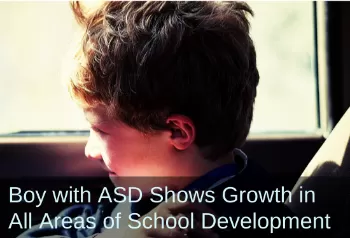Primitive Reflex Integration Case Studies
Boy with Severe Autism Makes Remarkable Progress in Play, Academics, Speech, Gross Motor and Fine Motor Skills
First grader exhibits global improvements after doing rhythmic movements
This child with ASD struggled in many functional areas, and had challenges with behavior, sensory processing, transitions, and self-regulation. He was unable to engage with the people around him in a positive way. Upon receiving rhythmic movements, he started showing immense changes in all life areas.
Submitted by JM, Occupational Therapist

| Before | After |
|---|---|
| Required a visual picture schedule to help with transitions | Transitions without a visual picture schedule |
| Required a one-on-one paraprofessional in classroom full-time | No longer requires a one-on-one paraprofessional |
| Routinely screamed at school staff and refused to participate in activities | Participates in classroom activities; plays with peers |
| Required headphones in the cafeteria | Tolerates cafeteria noise without headphones |
| Poor school skills | OT sees "remarkable progress" in academics, gross motor skills, and fine-motor skills |
I first met Briden as a student who was transitioning into public school from preschool; however, Briden never attended the preschool setting. His parents kept him home, and he only participated in outpatient speech and language therapy, occupational therapy, and physical therapy. He has severe autism and was a possible runner. He screamed at the school staff a lot and repeatedly said "no" to everything asked of him.
Rhythmic movements from the Brain and Sensory Foundations course were integrated into Briden’s school therapy for first grade in August. He was given an exercise program to perform at home. Slowly, changes began happening with Briden. He no longer needed a visual picture schedule to help him transition. As a kindergartner, he required a one-on-one paraprofessional to work with him full time. As a first grader, he no longer needs assistance from a paraprofessional. He started learning people’s names at school and greeting many people in the mornings. He now sits with the regular education students at car rider duty and listens for his name and walks out like all the other students to go home. He used to have to wear headphones in the cafeteria because it was too loud. Not anymore.
Briden has made remarkable progress in academics, speech, gross motor and fine motor skills. He is able to participate in playtime with other students instead of just playing by himself. There is a new sibling at home and Briden acknowledges the presence of his older and younger siblings now.
Different people are starting to notice Briden’s growth in all areas within the school environment. We have recently integrated the use of a 5-step balance process to incorporate age appropriate handwriting skills. He can hold a conversation with school staff. I contribute his success to the use of the rhythmic movements and 5-step Balance process from the Brain and Sensory Foundations course, which has made a difference in his different therapies, academic environment and daily routines at home. He is learning to like to swing, allowing him a new pastime on the playground.
[Edited for length and clarity; emphasis added]
*Disclaimer: The activities in the Brain and Sensory Foundations curriculum make use of the natural processes of neuroplasticity and development that are innately wired in the design of human beings to promote maturity and function. These activities appear to calm, organize, and mature the neuro-sensory-motor systems just as we see in the healthy development of human infants. Individual results may vary, and we do not claim to offer a diagnosis or cure for any specific condition or disorder. The Brain and Sensory Foundations activities appear to improve overall functioning resulting in measurable improvements for a range of conditions as demonstrated in over 1800 case studies from participants.

